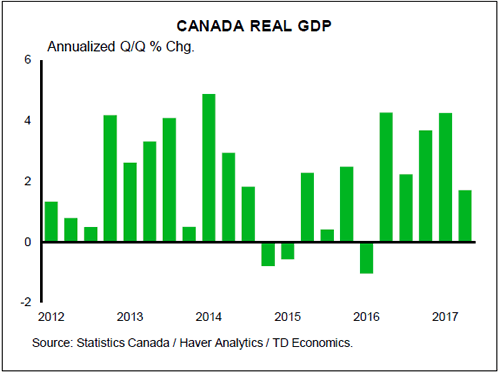U.S. Highlights
- Economic policymakers in Washington squeezed a lot in this week before heading home for the holidays. As expected, the Fed raised rates a quarter point and upgraded their economic growth forecasts.
- Republican members of Congress rushed to wrap up a compromise tax plan to be voted on early next week. While the final details are not yet known, the plan is likely to provide a modest boost to growth over the next few years. But, it has several potentially negative consequences for government finances over the longer-term.
- Our Quarterly Economic Forecast also features an upgraded economic outlook, in part reflecting better momentum in the second half of the year, and fiscal stimulus.
Canadian Highlights
- November saw healthy gains in housing resale activity as markets continue to come off the lows of the summer. In contrast, October manufacturing data was weak on the back of since-resolved disruptions in the auto sector.
- Bank of Canada Governor Poloz gave a relatively hawkish speech, painting a positive picture in remarks meant to focus on his worries. He followed this with more cautious remarks to CBC, suggesting that markets should put less stock in his words, and more in the economic data.
- To that end, our latest forecast sees continued economic momentum heading into 2018. As this forecast gets realized, the stage will be set for further Bank of Canada tightening, albeit at a gradual pace.
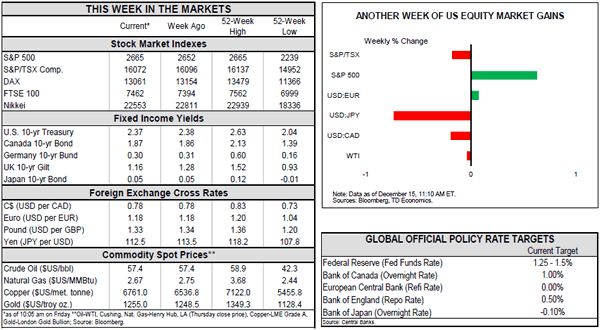
U.S. – Taxmas is Coming and the Debt is Getting Fat
Economic policymakers have been squeezing a lot in before heading home for the holidays. The Fed raised interest rates this week, as Janet Yellen gave her last press conference as Chair. Congressional Republicans were busy wrapping up a compromise tax cut plan. They face a new sense of urgency, since they will face a diminished Senate majority in the New Year once the newly elected Democratic Senator from Alabama takes office. At time of writing, the full details of the tax cut are not yet known, but the House and Senate are expected to vote on it early next week.
Given the high likelihood of a fiscal boost, our latest Quarterly Economic Forecast, released this week, incorporates a modest boost to real GDP over the next few years (Chart 1). It’s "Onward and Upward" for the U.S. economy over the next two years, with growth expected to accelerate from 2.3% in 2017 to 2.6% next year.
Even before a tax cut, the U.S. economy appears to be hitting a sweet spot. The unemployment rate is at a 17-year low, businesses are ramping up investment and inflation remains contained.
The consumer continues to be a stalwart of the economy. This was confirmed by a strong retail sales report for November. Consumer spending growth is on tracking for a healthy 2.8% annualized pace in the fourth quarter, which marks a rebound from a hurricane-dampened 2.3% pace in Q3.
The Fed also raised its economic growth forecast, but left its expectation for the number of rate hikes over the next year unchanged. The reason for the seeming inconsistency is unclear, but likely it is in part because of continued weakness in inflation would have necessitated a downgrade in the number of hikes, were it not for the offsetting growth upgrade.
All told, this is not a picture of an economy calling out for a fiscal boost. Moreover, deficit-financed tax cuts have several potentially negative consequences for the federal budget, and the economy as a whole. First, fiscal stimulus in an economy running full tilt is likely to stoke higher wages and inflation, and could result in a slightly faster pace of rate hikes by the Federal Reserve, ultimately dampening the support to growth. Second, since the personal tax cuts are temporary, a future Congress will need to deal with another fiscal cliff down the road. Third, higher deficits over the next few years (Chart 2)also make it more difficult for the government to respond to a potential economic downturn.
Finally, the plan is estimated to add about one trillion dollars to a debt burden that was already slated to grow due to rising expenditures from an aging population. This means interest costs will eat up more of the budget, leaving less room for other priorities. Larger government debt burdens also crowd out investment in the private sector, dampening productivity growth over the longer term. And, it raises the likelihood of a fiscal crisis – where interest rates on federal debt would rise suddenly and sharply as investors demand additional compensation to hold U.S. debt.

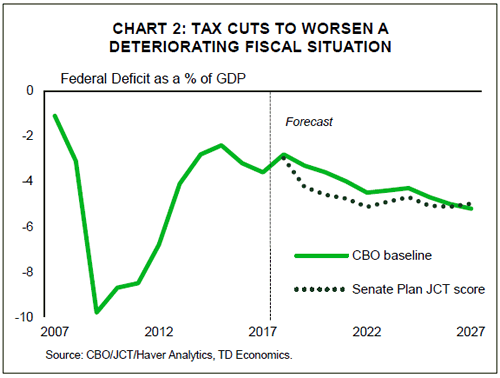
Canada – Decoding Poloz
The past week gave us further updates on economic progress heading into the close of 2017. Housing continued to recover, recording a fourth straight monthly increase in resale activity in November, helped by a recovering Ontario market (Chart 1). As discussed in our latest Forecast, changes to underwriting guidelines will impose a new headwind to the sector in 2018, with the fourth quarter likely to be benefitting from some pull-forward of activity ahead of this change. At the same time, manufacturing sales took a step back in October, but this was to be expected as retooling and labour disruptions affected two large auto manufacturing facilities. Importantly, both facilities have since returned to full production, and the forward-looking components of the report remained healthy, suggesting that October should be the last month of setbacks in a sector that has been plagued by disruption in recent months.
Undoubtedly, the key event of the week was a speech by Bank of Canada Governor Stephen Poloz on December 14th. Monetary policy may often be seen as a boring, technical field, but Governor Poloz did his best to make it interesting, and markets took notice, as reflected by moves in the loonie (Chart 2). To begin with, Poloz opened a speech meant to focus on his worries with an upbeat assessment of the economy. Areas of concern were followed with notes that progress is being made towards addressing issues such as high house prices and household debt and what he perceives to be weakness in labour markets. Also notable for a risk-oriented speech, NAFTA negotiations were not mentioned – the only reference to trade was a positive remark on exports.
The somewhat hawkish tone was further reinforced in the Q+A period. When asked about his use of the word ‘caution’, which markets seemed to read as indicating a hold, he referred to the dictionary definition, and provided the metaphor of driving home in a snow storm. In effect, that caution doesn’t mean standing still, it means going slow. The net result was to send the loonie roughly a cent higher against the U.S. dollar as the overall tone of the Governor’s remarks suggested rate rises may be coming sooner than markets were anticipating.
It was not to last however. Later in the day, in a pre-taped interview with the CBC, the Governor struck a much more dovish tone, noting that he wants the economy to "run hotter for a while" to absorb remaining labour market slack. When asked about the Federal Reserve’s outlook for interest rates (with the overnight rate seen breaching 3% by 2020), Poloz stated that he sees the Canadian economic cycle being about a year or two behind the U.S. This was enough to pare back some of the earlier gains, leaving the loonie up just 0.3 cents on the day.
The key question is thus: what message was Poloz trying to convey? The answer may ultimately be none at all. Recent communication has emphasized data dependency and keeping options open, and with the shifting tone seen on the 14th, Poloz may be telling us not to hang on his every word. This goes back to the core notion of ‘data dependency’, as exemplified in September’s hike. Ultimately, should fourth quarter economic growth come in as expected, another rate hike likely won’t be far behind.
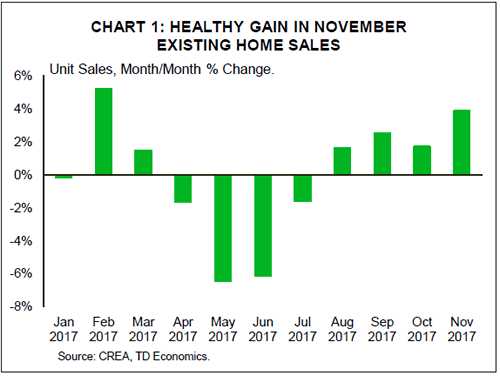

U.S.: Upcoming Key Economic Releases
U.S. Personal Income & Spending – November
Release Date: December 21, 2017
Previous Result: Income 0.4% m/m; Spending 0.3% m/m
TD Forecast: Income 0.5% m/m; Spending 0.5% m/m
Consensus: Income 0.4% m/m; Spending 0.4% m/m
Headline PCE inflation is expected to pick up to 1.8% in November, consistent with the rebound in the CPI on higher energy prices. Food prices are expected to be flat for the fourth month, though slightly higher on a y/y basis. Excluding food and energy, core PCE inflation is likely to firm marginally to 1.5% y/y on a relatively weak 0.1% m/m. Details should show several categories acting as a drag, notably apparel (as seen in the CPI report), while there is scope for healthcare services to disappoint its CPI counterpart (in line with continued weakness in PPI healthcare services categories). This still points to a 0.1% m/m rise in the core PCE, matching the increase in the core CPI.
Nominal PCE (personal spending) is expected to rise 0.5% in November, pointing to Q4 real consumer spending near a 2.5% pace. We expect gains to again be driven by nondurables and services, partially offset by a drag from vehicle sales which continued to contract in November. We also expect a firmer 0.5% increase in November personal income.
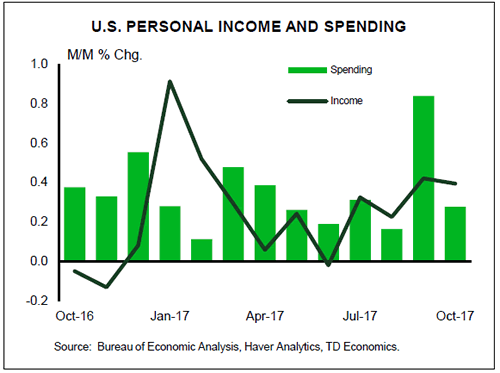
Canada: Upcoming Key Economic Releases
Canadian CPI – November
Release Date: December 21, 2017
Previous Result: 0.1% m/m
TD Forecast: 0.2% m/m
Consensus: N/A
We expect headline CPI inflation to jump to 1.9% y/y in November from 1.4% y/y, driven by a surge in gasoline prices. The sharp pickup will be short-lived as base effects are adverse over the coming months and gasoline prices are set for a partial reversal in December. This should lead headline inflation back down to 1.7% y/y in December before bottoming out at 1.4% y/y in January. That said, outside of energy, the inflation picture should be fairly constructive in November. After a series of declines, food prices have scope for a rebound helped by a weaker Canadian dollar, which by November returned to its pre-July hike levels. Other past sources of weakness also should show some recovery, such as vehicle prices. Excluding food and energy, prices should post an acceleration to 1.6% y/y, the highest read since March. The rapid absorption in labour market slack, which is now more apparent in wage growth, also points to stable to higher readings in the three new core metrics (CPI common, trimmed mean and median), which would be viewed favourably by the BoC.
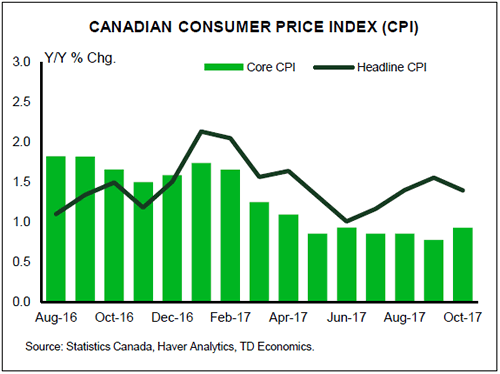
Canadian Retail Sales – October
Release Date: December 21, 2017
Previous Result: 0.1% m/m, ex-auto: 0.3% m/m
TD Forecast: 0.6% m/m, ex-auto: 0.8% m/m
Consensus: N/A
TD expects headline retail sales to post a 0.6% advance in October, led by a solid pickup in core sales. Auto sales should remain largely unchanged which will exert a modest drag on the headline print and leave ex-auto sales up 0.8%, while gasoline station sales will face a headwind from lower prices at the pump. Core retail sales should benefit from continued gains in the labour market and the persistence of wealth effects, as demonstrated by the strong increase in Q3 consumer spending. On a volumes basis, retail sales should underperform the nominal print though we still expect a positive contribution to industry-level GDP.

Canadian Real GDP – October
Releases Date: December 22, 2017
Previous Result: 0.2% m/m
TD Forecast: 0.2% m/m
Consensus: N/A
TD looks for a 0.2% advance in industry-level GDP for October, with growth led by the services sector. Goods sector output will be constrained by production woes in the automotive industry, reflecting both retooling shutdowns and labour disputes. Utilities output should also be a source of downside as the late summer heat wave fades, though a surge in residential construction should provide an offset. Services should show a rebound in retail and wholesale trade in addition to a solid contribution from real estate as the Toronto housing market continues to stabilize. Our forecast is consistent with Q4 growth near a 3% pace, which provides further reason for the Bank of Canada to hike in Q1 2018 given their assertion that the economy is operating near full capacity.
